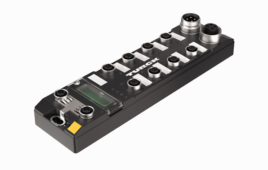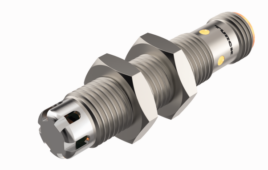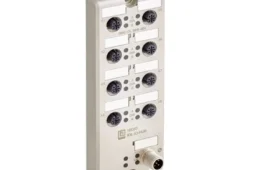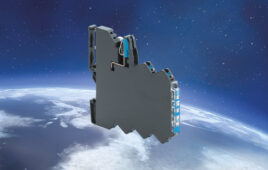When OEMs can standardize their designs with one family of I/O products, it simplifies their efforts and gives them the flexibility to adapt controller platforms as needed.
By Matt Hou, Electrical Engineer, Dinkle International
Original equipment manufacturers (OEMs) of machinery and process systems come in all shapes and sizes, serving a variety of industries, but they all rely on some type of input/output (I/O) hardware to interface field devices with the controller platform. The I/O is the nervous system used by the controller brain to monitor and command the sensors, valves, motors, and much more.
OEMs are experts when it comes to the design, fabrication, and operation of their equipment. Each OEM typically has a preferred automation platform, but in cases where they deliver systems to different end users, those very users may impose requirements regarding makes and models of programmable logic controllers (PLCs) and human-machine interfaces (HMIs). Quite often end users are sensitive to the PLC and HMI platform selection because they need to match the standards and personnel training at their facilities.
Therefore, OEMs are looking for a middle ground where they can maintain consistency in their designs while delivering customer-requested automation platforms. One way to do this is to standardize on a remote I/O system which is easy to work with, comes in a variety of signal configurations, and integrates with any type of PLC platform. This article identifies how standardizing on common I/O systems can help OEMs simplify their work and gain flexibility.
Benefits of standard I/O systems
Reliable data communications with I/O connected to field-located sensors and actuators is essential for proper real-time equipment control. Additionally, I/O is needed for data collection and analysis by historians, manufacturing execution systems, enterprise resource planning, and other systems.
More than ever, users are installing large numbers of input points, moving beyond basic control, and applying a greater focus on gathering data for analysis. Seamless connectivity between the field data and supervisory computing systems is foundational for industrial internet of things (IIoT) initiatives.
Designers need an I/O system for control and data monitoring which can be implemented consistently across their entire product line wherever it is needed (Figure 1). Switching I/O systems based on customer-requested controllers adds complexity and cost. However, using standardized I/O systems lets both designers and end users achieve their goals.

Figure 1: Designers want standardized remote I/O systems with the right features and compact form factors for use in main control panels, remote panels, and anywhere else they are needed.

Most PLC automation vendors offer their own remote I/O systems to integrate specifically with their controllers. Even when these vendors tout some level of improved alignment between their PLCs and remote I/O, these vendor-sourced products tend to come at a price premium and with constraints. OEMs need independent I/O solutions that give them more options, not less.
Remote I/O basics
Basic wired I/O signals use voltages and currents to transmit information from a field device to an I/O module, which in turn communicates with a controller. Discrete (sometimes called “digital”) point signals are either “on” or “off.” Analog point signals vary over a certain signal span to indicate a range of values. Inputs supply field information to a controller, and outputs send controller commands to the field devices.
There are many voltage, current, and wiring standards for each of these four basic I/O point types, and there are other special considerations such as how fast a point responds, accuracy, whether an interposing relay dry contact module is required, and other factors.
I/O signals may be located anywhere on a machine or equipment. While it is possible to wire all these items back to a central location, it is more convenient to install I/O modules in logical locations close to the field signals, especially where there are high quantities of I/O points localized together. This approach is called remote I/O because it is located away from the controller.
Any remote I/O must use some form of networking and communications protocol to interact with the controller. Today a prominent industrial networking method is Ethernet, but there are still many applications where classic RS-485 serial communication makes sense. No matter what the network, the goal is to minimize cabling and maximize connection distances.
Remote I/O key features
When OEMs can standardize on a single remote I/O system, they can design their equipment with common I/O panels. This reduces engineering, fabrication, and long-term support efforts.
Following are key features to look for with any remote I/O system (Figure 2):
• Compatible with standard industrial communication protocols
• Supports flexible and expandable architecture arrangements
• Compact form factors with fast assembly
• Simple wiring
• Wide selection of I/O modules for any signal type
• Easy configurability
• Clear indication of module and point ID and status
• Meets IEC and UL standards
• Economical

Figure 2: Remote I/O systems, like the Dinkle iO-GRID M, feature compact and modular form factors, support for the most popular industrial communication protocols, and easy push-in wiring.
There are many industrial communication media types and protocols. Modbus TCP over Ethernet and Modbus RTU over serial cable are two of the most widely recognized and implemented industry standards. Therefore, any remote I/O solutions should be compatible with these for best interoperability with a range of controllers. Remote I/O systems with options for gateway or master modules provide the most architectural flexibility, allowing users to scale designs from the smallest to largest installations. A wide selection of I/O modules ensures users can get what is needed to satisfy any industrial field application.
Space is always at a premium, so compact form factors using a modular arrangement—often with a power and communications bus plate which accepts snap-in I/O modules—is the most popular way to install the right quantity and configuration of I/O wherever it is needed. For some applications users may need washdown-rated devices, but remote I/O is more commonly selected for cabinet-mounting arrangement protected by an enclosure.
The remote I/O system’s physical arrangement should also allow for easy servicing in the future. While screw-type terminal blocks have been the typical connectivity method in years past, many machine and equipment designers have moved to push-in design terminals to enable fast and tool-free installation with long-term stability, even in high vibration environments.
Most I/O modules have some on-board settings for configuring how they respond to and transmit field signals. When PLC automation vendors also offer remote I/O, they may point out some native configuration capabilities between the PLC and the remote I/O. However, these same capabilities may limit the usefulness of such I/O with other automation platforms.
For this reason, a better way is to enable the remote I/O to be configured locally using simple software and a standard micro-USB cable. Users can perform all the necessary configuration, even on the benchtop before installation, and enable the remote I/O to work equally well with any controller of choice.
When the I/O is configured, commissioned, and operated over the years, it is important for it to offer clear indication, usually via LED lights, to indicate status. Clear module and point marking provisions also improve serviceability.
Designers will also want I/O modules meeting the typical UL and IEC requirements found throughout industry. If all the preceding features are available, then a final consideration is usually price. Fortunately, remote I/O systems engineered using standards to work with many controller types are often the most economical choice.
I/O integration examples
One packaging OEM supplies relatively widespread arrangements of systems using conveyors, boxers, sealers, labelers, and more. The OEM used Dinkle iO-GRID M remote I/O, enabling them to apply standard I/O products distributed throughout the various equipment types, and automated by a single PLC. Installation time was reduced by 40%, setup costs were reduced by 50%, and they had flexibility to incorporate any type of field equipment.
In another case, a systems integrator (SI) was tasked with automating water treatment equipment in a multi-level factory. The process equipment included storage tanks, sedimentation tanks, and pump controls distributed throughout the factory (Figure 3). By incorporating remote I/O, the entire plant could be automated with a single PLC, with wiring material cost reduced by 40%. Choosing an independent brand for remote I/O reduced the hardware cost for this portion of the automation by 50%. Future expansion is easy over Modbus, and the SI can apply the same concepts on other upcoming projects using any type of PLC.

Figure 3: Remote I/O always saves on wiring material costs, and often helps SIs design space-efficient automation panels for every type of control situation.
An OEM of machinery used to manufacture automotive components creates production lines from many single-station machines. Because they selected an ultra-compact remote I/O system that can communicate with the majority of PLC brands, they have flexibility to design the I/O into any type of station, and easily integrate it with any PLC required by the end user.
Standardized remote I/O simplifies OEM designs
Reliable remote I/O systems are needed by OEMs of automated machinery and process systems for real-time control and IIoT monitoring. Many designers may lean toward using I/O offered by their automation platform vendors. However, when OEMs are faced with integrating many makes and models of controllers, or with an increased need for IIoT monitoring, many find that choosing a standardized I/O solution helps them maintain commonality in their designs and reduce costs. Modular remote I/O is a popular way to realize these benefits and achieve seamless connectivity from the field up to supervisory systems, while providing greater design flexibility.
Dinkle International
www.dinkle.com
Filed Under: IoT • IIoT • Internet of things • Industry 4.0, I/O modules




